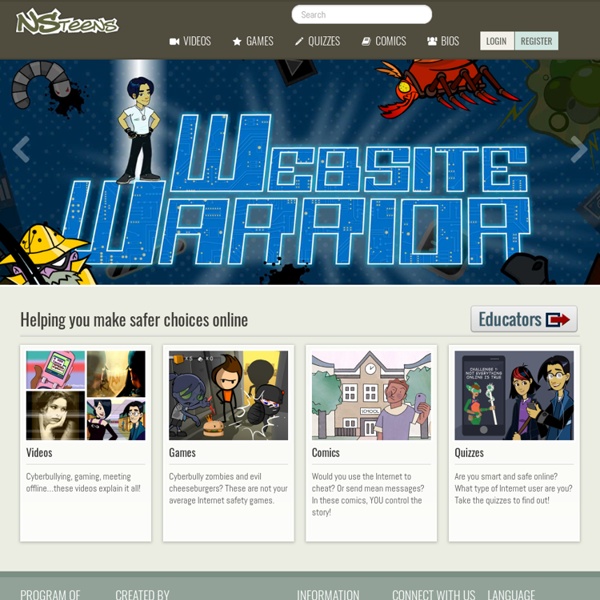



A Copyright-Friendly Toolkit However fabulous Creative Commons and Public Domain content may be, sometimes you really need to use copyrighted material. Say you plan to comment on popular media or current events. For instance, you may be planning to critique the portrayal of Native Americans in commercial films. You are going to want to “quote” some commercial films like Pocahontas, Lone Ranger, and Dances with Wolves. If you are reviewing a book, you may want to share its cover art. You may use copyrighted content without asking permission if you believe that your use falls under the doctrine known as Fair Use.
SurveilStar Any Parental Control Online Safety Tips for Children, Young People, and Parents! As more and more children are involved in various online activities, responsible parents should ensure kids online safety by all possible means. Visit these sites to get resources and practical advice to help young kids, kids, teens and parents safely enjoy the online world. www.safekids.com From the SafeKids.com.
10 changes a school library must consider in the digital era 6. Showcase: Part of having meaningful resources is by letting students and staff know what’s available, and showcasing content can be done through a number of online platforms, said Luhtala. For instance, GoodReads can be used to highlight summer reading content, while Aurasma can be used as a visual guide to printed content. Pinterest, Destiny Quest, QR codes, and ThingLink can also help librarians showcase collections. Internet Filtering at Schools Is Problematic Giving all children access to the Internet and computing became a rallying cry for educators and elected leaders in the 1990s. In March 1996, President Clinton and Vice President Gore led 20,000 volunteers in a one-day effort to connect thousands of California public schools to the “brave new world of mouse clicking and web surfing.” Yet that brave new world remains unconquered for many students and schools, especially in rural and high-poverty communities. Some have coined the term “digital redlining” to describe how advanced technology has been deliberately denied from certain areas based on geography as well as the race, ethnicity, and income of residents. In the intervening years, the spotlight has pivoted to the so-called “connectivity gap”—which hurts schools without high-speed Internet connections—and the homework gap—which hurts students unable to access wireless and broadband connections from home. This finding is confirmed by anecdotal and empirical evidence.
Libraries matter: 15 fantastic library infographics Library infographics presented below clearly show that being a librarian today is not about surviving any longer. It’s great that such infographics are created. Infographics are a fantastic way to draw attention of online users, and give facts not only in a more digestible, but also highly entertaining way. Many people still perceive libraries as awesome-looking magical places, full of a scent of old paper. Web Evaluation: Does This Website Smell Funny to You? One of my friends spent this past weekend working with her 2nd grade daughter on a research project. While her daughter flew through the arts and crafts portion and was able to handwrite the “sloppy copy” of her presentation, she struggled when it came to typing the final draft. She didn’t know where the period was. She didn’t know how to use the shift key (and then declared that turning caps lock on and off was far superior and easier than using the shift key).
Why reading matters infographic - Smart HiveSmart Hive Infographic on Reading After doing a lot of research on the impact of reading with and to young children, it is easy to see why reading matters. The evidence is overwhelming. Suffice it to say that it may be the single best thing you can do for your children. Even living in a lower socio-economic class doesn’t impact a child’s future as much as whether they were read to and that they learned to read well. Reading really matters.
Ranganathan on shyness: Get over it! - OCLC Next Advice from the father of library science In 1931, S.R. Ranganathan, a mathematician and librarian who is widely regarded as a founder of modern library science, published his seminal work, The Five Laws of Library Science. Advocacy, Legislation & Issues In the span of a single generation, the Internet has revolutionized the basic functions and operations of libraries and schools and expanded exponentially both the opportunities and challenges these institutions face in serving their users. During this time many schools and libraries in the United States have installed content filters on their Internet access. They have done so for a variety of reasons, not least of which is the requirement to comply with the Children’s Internet Protection Act (CIPA) in order to be eligible to receive federal funding or discounts through the Library Services and Technology Act, Title III of the Elementary and Secondary Education Act, and the Universal Service discount program (E-rate), or to comply with state filtering requirements that may also be tied to state funding. Their rationale for filtering is that it is better to have filtered access than no access.